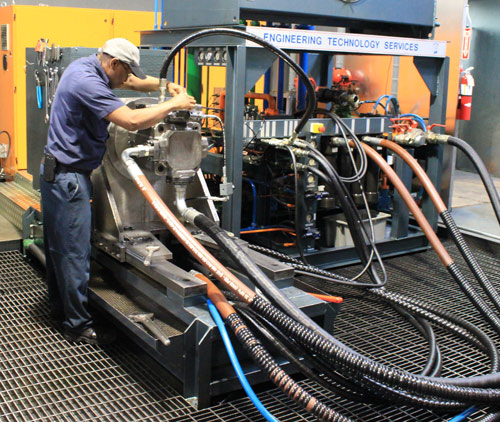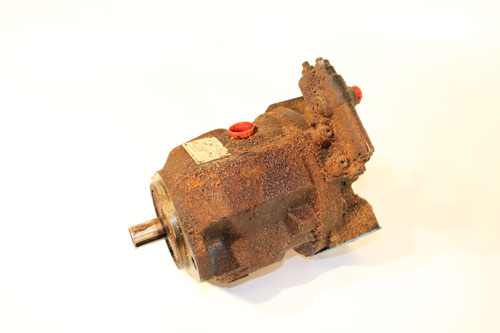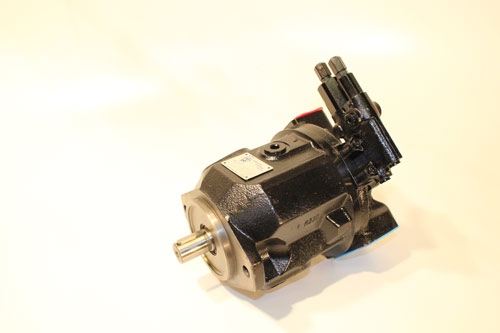WHEN fluid-power components like pumps, motors, valves and cylinders fail, the overriding goal is to get a system up and running again as soon as possible. One option is simply to purchase and install a new replacement part, but a repaired or remanufactured component is often the more economical option.
Depending on the unit, almost every constituent part can be replaced or repaired, provided a suitable replacement is available. As a general rule, a repair makes sense if the cost doesn’t exceed 60 to 70% of the cost of a new component. Beyond that, the user is typically better off with a new unit. However, if a new product is not readily available and a critical or expensive machine or production line is down, repair is still practical at a higher cost.
Technicians first make a full inspection and diagnose the problem. While sources of failures come in every imaginable shape and form, the root cause generally falls into just a few areas. Sometimes components just wear out. But premature failures typically result from contamination, cavitation, overpressurization and excessive heat. Thus, installing a robust filtration system, keeping components cool, and following a disciplined maintenance program are critical to extending component and machine life. Finally, some components break due to incorrect application, installation or commissioning—failures that are often preventable.
Technically savvy repair shops tear a unit down and try to bring it back to “as new” condition. All critical dimensions and surfaces are inspected and measured. Seals and low-cost consumable parts like springs, washers and shims tend to be replaced. Likewise, bearings will be inspected and possibly replaced. In more-serious cases, say internal wear due to contamination damage in a piston pump, lapping the surfaces might be suitable if still within acceptable tolerances. Otherwise, the technician may need to remanufacture or replace rotary barrels, pistons, and other internal parts. That can ultimately extend to replacing other major components like housings, covers, relief valves, controllers and charge pumps.
In the worst case, a completely new unit can be built from parts, although that is not the norm.
Another issue is whether to repair/remanufacture a unit with parts sourced from the original hydraulic OEM or with aftermarket replacement parts. The hydraulic repair industry broadly falls into three business sectors. Hydraulic component manufacturers often tend to serve large machine builders directly, with their own parts. But they often leave user service and support to distributors and large, sophisticated repair houses. Some use OEM parts exclusively, some do not. Further removed are smaller shops that can find OEM replacement parts costly and not readily available. As a consequence, these firms often rely on parts from aftermarket sources—usually offshore parts manufacturers. While these reverse-engineered aftermarket parts almost always cost less than OEM parts, quality concerns are currently an important issue within the fluid-power industry.
After completing the repair, testing and calibration are also critical to ensure repairs are done right the first time. The best repair companies have rebuilding and testing capabilities that are as good as or better than the OEM’s themselves, said Brian Berry, president of Engineering Technology Services, a remanufacturer of high-end pumps and valves. That’s necessary simply because hydraulics has gotten more complex. One issue is that newer equipment operates at higher pressures, said Berry. While 3,000 psi used to be the upper limit for hydraulic pressure, newer systems in some cases operate to 7,000 psi or higher. That typically demands piston pumps and motors, and piston designs are more complex than lower-pressure gear and vane pumps.
And newer components routinely have integrated electronics, digital controls and sophisticated software. Unfortunately, the complexity of today’s hydraulics means pure mechanical aptitude is no longer sufficient to fix many components. Given the sophistication of the latest controls and software, there’s a shortage of qualified technicians who can handle all aspects of inspection, testing and calibration.
Components with higher operating pressures and electronics controls also tax the capabilities of test equipment at many repair facilities, said Berry. Small shops will make repairs and perhaps run basic tests, but they are not capable of performing full-function tests. Other, typically larger repair shops have made significant investments in state-of-the-art test stands for qualifying dynamic open and closed-loop systems.
Not surprisingly, the price of a repaired or rebuilt component can vary widely depending on the expertise behind it. Experience and specialized skill is required to correctly diagnose, rebuild and test hydraulically powered equipment. Costs include the expertise for diagnosing the failure, recommending the proper repair, whether to rework or replace a part, and whether to use genuine or aftermarket parts. This ultimately speaks to the overall competency of the repair company and the capabilities of the staff and testing equipment.
The quality of the repair shouldn’t be driven solely by price, either, stressed Steve Matthew, president of Wooster Hydrostatics. Companies that shop by price alone are usually disappointed by the outcome, as the repair may not hold up. Consider the time and labor needed to remove a failed pump or cylinder from a machine and install a rebuilt one, plus the cost of the repair itself, as well as the cost of machine downtime and lost productivity, and it quickly adds up. Cutting corners on parts or testing and finding that the repair quickly fails, and forcing the user to start over at square one, gets expensive. That’s why it’s essential to get repairs right the first time.
Filed Under: Cylinders & Actuators, Fluid Power Basics, Fluid Power World Magazine Articles, News, Pumps & Motors


